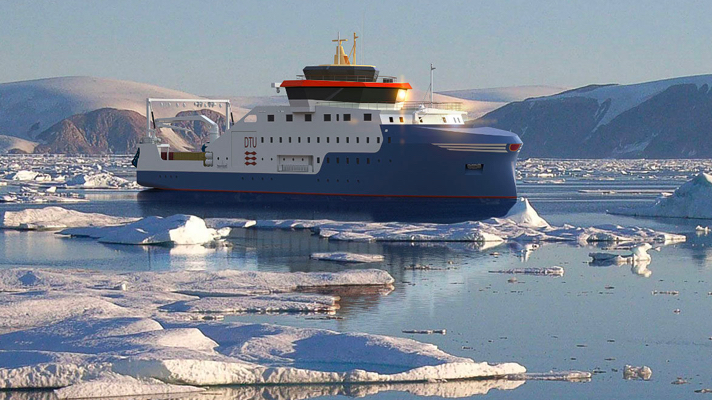Knud E Hansen and DTU Aqua (Technical University of Denmark) have come up with a design for a new 65-metre multidisciplinary marine research vessel to replace the university's aging R/V Dana IV. The vessel will be able to conduct marine research worldwide, including in arctic waters.
The purpose of the project has been to develop a concept design and budgetary cost estimate for a new research vessel. The current vessel Dana IV is in need of replacement as it is facing a forty-year class survey in ultimo 2022. The new vessel is to attract international scientific projects for DTU Aqua. The multidisciplinary research vessel is designed and optimised for cost-effective fish stock assessment, hydro-acoustic studies and biological, chemical and physical oceanography research.
The following objectives have been prioritised:
- Maximum capacity for hydro acoustic scientific performance
- High efficiency in fish stock monitoring
- High scientific multidisciplinary performance through versatile design
- Year-round operation in North Sea and Baltic
- Summer/autumn operation in Greenland and Polar waters
- Low operational costs
Polar Code
The DTU Aqua operating area will primarily be the Baltic Sea, the Gulf of Bothnia, the Kattegat, the Skagerrak, the North Sea, the North Atlantic and Greenlandic waters in summer and autumn. The vessel is designed to operate worldwide including the geographical coverage area of the IMO Polar Code up till approximately eighty degrees North depending on the ice situation.
Low Underwater Radiated Noise
The vessel is designed for class notation DNVGL ✠ 1A, SPS, EO, DYNPOS (AUTS), PC (6), and to comply with the ICES CRR 209 standard for low underwater radiated noise (URN) emission. In carrying out the design, the key design drivers and other design issues have been scrutinised and evaluated to arrive at optimal design solutions, which prioritises regulatory compliance, safety, and environment.
Accommodation
The capacity of the vessel includes single and double cabins for 34 crew and personnel of which an average of eighteen to twenty is expected to be researchers depending on the specific research operations.
Scientific Capacity and Equipment
The vessel is arranged with a full suite of hydro-acoustic transducers, multiple laboratories trawl gear, cranes, CTD and deck equipment to support multi-disciplinary research operations. The CTD cranes can operate and sample water to depths of 3000 metres as well as handle underwater equipment ranging from small plankton nets and bottom corers and towing of multinets.
The trawl gear is arranged for flexible and efficient operation with multiple net drums and flush deck hatches to two receiving bins. Laboratories are arranged adjacent to CTD Hangar, and below trawldeck to allow efficient handling of fish samples and a variety of wet or dry laboratory work to be carried out simultaneously.
The acoustic transducer suite can carry out a full range of hydro-acoustic surveys, such as bottom mapping, sub-bottom profiling, current profiling, 3D visualisation of fish stocks and biomass estimation.
The multifunctional deck is equipped with a bolt grid for flexible arrangement of research gear combined with up to four (4) ISO 20" containers. The side bulwark for the trawl lane, as well as the transom bulwark aft and the starboard side can be removed, so that the overall multi-deck area can be expanded to include the trawl lane.
Budget
The building costs of the vessel have been estimated in consultation with several shipyards within continental Europe. The design study concludes that it is possible for DTU Aqua to have the research vessel designed, built and commissioned within a total budget of 340 million Danish krones (over 45.5 million euros).








